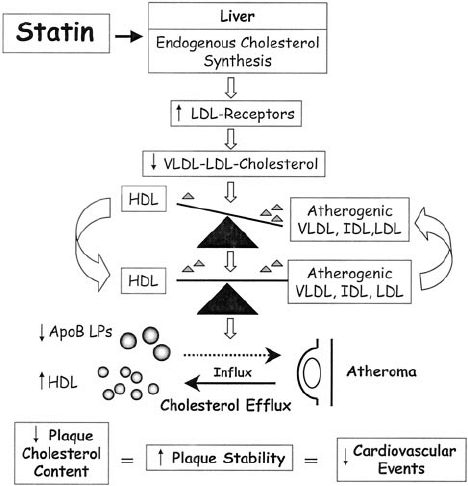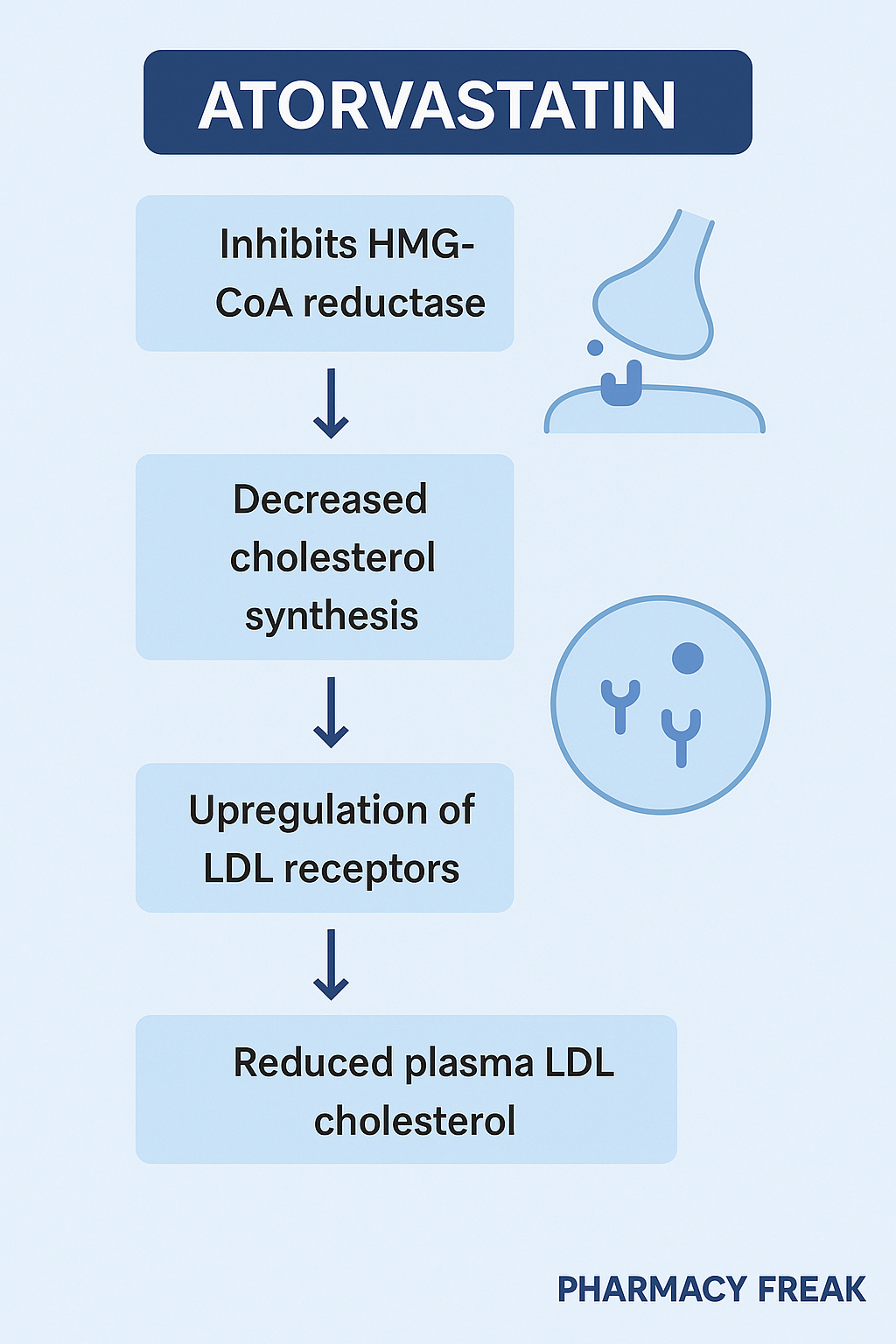Table of Contents
🔍 Introduction
Atorvastatin is a widely used lipid-lowering agent that belongs to the class of HMG-CoA reductase inhibitors, commonly known as statins. It is one of the most prescribed drugs worldwide due to its effectiveness in lowering LDL cholesterol and reducing cardiovascular risk.
It plays a major role in:
- Hyperlipidemia
- Atherosclerotic cardiovascular disease prevention
- Diabetes and metabolic syndrome with dyslipidemia
Because of its clinical importance and frequent appearance in pharmacology exams, Atorvastatin is an essential drug to understand for PharmD, MBBS, and B.Pharm students, as well as GPAT, NEET-PG, and NCLEX aspirants.
🧬 Stepwise Mechanism of Action of Atorvastatin
- Selective Inhibition of HMG-CoA Reductase:
Atorvastatin competitively inhibits 3-hydroxy-3-methylglutaryl-coenzyme A (HMG-CoA) reductase, the rate-limiting enzyme in the mevalonate pathway responsible for cholesterol biosynthesis. - ↓ Cholesterol Synthesis in Liver:
Inhibition of HMG-CoA reductase reduces the conversion of HMG-CoA to mevalonic acid, a cholesterol precursor, thereby decreasing hepatic cholesterol production. - Upregulation of LDL Receptors:
The reduction in intracellular cholesterol stimulates upregulation of LDL receptors on hepatocyte surfaces, increasing uptake of circulating LDL particles from the blood. - ↓ Serum LDL, VLDL, and TGs:
This leads to a significant reduction in serum LDL-cholesterol, triglycerides, and VLDL, with a modest increase in HDL. - Pleiotropic Effects (Additional):
Atorvastatin also improves endothelial function, stabilizes atherosclerotic plaques, reduces vascular inflammation, and exhibits antioxidant properties.

🧪 Pharmacokinetic Parameters of Atorvastatin
| Parameter | Value |
|---|---|
| Bioavailability | ~14% (oral) |
| Onset of Action | Within 3–5 days |
| Half-life | ~14 hours (active metabolites persist longer) |
| Protein Binding | >98% |
| Metabolism | Hepatic (CYP3A4 enzyme) |
| Excretion | Fecal (via bile), minimal renal |
💊 Clinical Uses of Atorvastatin
- Primary hyperlipidemia and mixed dyslipidemia
- Prevention of cardiovascular events in high-risk patients
- Post-MI and stroke secondary prevention
- Familial hypercholesterolemia
- Adjunct in type 2 diabetes mellitus with dyslipidemia
- Metabolic syndrome
⚠️ Adverse Effects of Atorvastatin
- Myopathy (muscle pain/weakness)
- Rhabdomyolysis (rare but serious)
- Hepatotoxicity (elevated liver enzymes)
- GI disturbances: nausea, constipation
- Headache, fatigue
- New-onset diabetes (possible risk with long-term use)
📌 Liver enzymes (ALT, AST) and creatine kinase should be monitored during therapy.
🔬 Comparative Analysis: Atorvastatin vs Rosuvastatin
| Feature | Atorvastatin | Rosuvastatin |
|---|---|---|
| Lipophilicity | Lipophilic | Hydrophilic |
| CYP Metabolism | CYP3A4 | Minimal CYP2C9 |
| LDL-lowering efficacy | High | Very high |
| Half-life | ~14 hours | ~19 hours |
| Use in renal disease | Use with caution | Preferred |
| Myopathy risk | Moderate | Slightly lower |
📝 Practice MCQs
Q1. Atorvastatin belongs to which drug class?
A. Fibrates
B. Bile acid sequestrants
C. HMG-CoA reductase inhibitors ✅
D. Niacin derivatives
Q2. The primary enzyme inhibited by atorvastatin is:
A. HMG-CoA synthase
B. HMG-CoA reductase ✅
C. Acetyl-CoA carboxylase
D. Farnesyl pyrophosphate synthase
Q3. What is the effect of atorvastatin on LDL receptors?
A. Downregulation
B. Destruction
C. Upregulation ✅
D. No change
Q4. Which of the following is a major adverse effect of atorvastatin?
A. Hepatitis
B. Myopathy ✅
C. Bradycardia
D. Diarrhea
Q5. Atorvastatin is primarily metabolized by:
A. CYP2D6
B. CYP2C9
C. CYP3A4 ✅
D. CYP1A2
Q6. The pleiotropic effects of statins include all EXCEPT:
A. Improved endothelial function
B. Reduced inflammation
C. Increased LDL synthesis ✅
D. Antioxidant action
Q7. In which condition is atorvastatin contraindicated?
A. Pregnancy ✅
B. Diabetes
C. Hypertension
D. Peptic ulcer
Q8. Which of the following lab values should be routinely monitored with statin therapy?
A. Serum calcium
B. Creatine kinase and liver enzymes ✅
C. Hemoglobin
D. Sodium
Q9. Which combination increases risk of myopathy with atorvastatin?
A. Metformin
B. Aspirin
C. Erythromycin ✅
D. Amlodipine
Q10. Atorvastatin is best administered:
A. On an empty stomach at bedtime
B. With food in the morning
C. At night (lipid synthesis is nocturnal) ✅
D. Every alternate day
❓FAQs
Q1: Can atorvastatin be used in pregnancy?
No. It is contraindicated (Category X) due to potential fetal harm.
Q2: Can it be given to diabetic patients?
Yes. It is often used in diabetics for cardiovascular protection despite a small risk of new-onset diabetes.
Q3: What should be avoided with atorvastatin?
Avoid grapefruit juice and drugs like erythromycin, which inhibit CYP3A4 and increase statin levels.
Q4: How long does it take for atorvastatin to work?
Significant lipid-lowering effect is seen in 2–4 weeks, though onset starts within 3–5 days.
📚 References
- KD Tripathi – Essentials of Medical Pharmacology, 8th Edition
- Goodman & Gilman – The Pharmacological Basis of Therapeutics
- Sparsh Gupta – Review of Pharmacology

I am pursuing MBA in pharmaceutical management from NIPER Hyderabad with a strong academic record and proven success in national-level pharmacy entrance exams. I secured AIR 61 in NIPER 2024 (MS/M.Pharm) and AIR 27 in NIPER MBA, along with AIR 147 in GPAT 2024 and AIR 907 in GPAT 2023. I also achieved AIR 6 in AIIMS CRE-2025 for Drug Store Keeper and was selected as a Pharmacist (AIR 61) for ESIC. Additionally, I was the Runner-Up in Round 2 of the EY Case Study Competition.
At PharmacyFreak.com, I aim to guide future pharmacists through expert content, exam strategies, and insightful resources based on real experience and academic excellence.
Mail- harsh@pharmacyfreak.com
